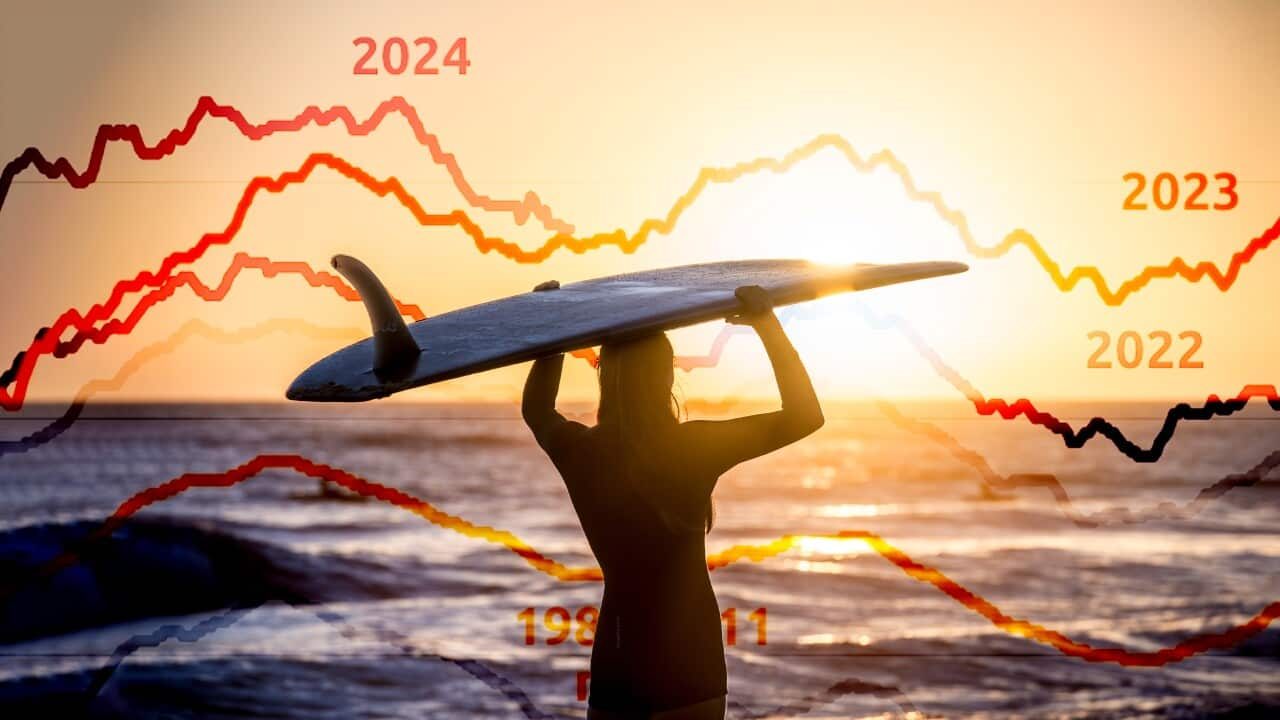Every day since March last year, daily heat records are reaching new heights and multiple climate records have been broken.
The "extraordinary" and unexpected phenomenon has concerned the world's climate scientists, who fear the severe impacts of global warming are emerging sooner than expected and may leave us in "uncharted territory".
As , the impacts of global warming are becoming more apparent each day.
Unusual temperatures recorded since March last year
The University of Maine's Climate Reanalyzer platform shows new daily records have been set for sea surface temperatures since around mid-March last year.
The record temperatures have been described as an "anomaly" by British climatologist Gavin Schmidt, director of NASA's Goddard Institute for Space Studies in New York City.

Daily sea surface temperatures have been breaking records since mid-March last year. Source: SBS News
In February, it was revealed the Earth had recorded land surface temperatures above the 1.5C Paris Agreement target for the first time.
The Paris Agreement is an international treaty that aims to keep global warming well under 2C and preferably at 1.5C.
Schmidt noted in March that mean land and sea surface temperatures had overshot previous records each month by up to 0.2C for the preceding nine months.
Schmidt described this as a "huge margin at the planetary scale", in a column for the scientific journal Nature.
Since then, temperatures have remained at record levels.
'Extraordinary' record-breaking streak
Data shows sea surface temperatures are still at record-breaking levels.
On 12 June this year, the daily temperature was about 0.7C higher than the 1982-2010 mean, climatologist Sean Birkel, developer of the University of Maine's Climate Reanalyzer, told SBS News.
The Climate Reanalyzer uses data from the United States' National Oceanic and Atmospheric Administration to track sea surface temperatures.

Sea surface temperatures have broken daily records since March 2023. Source: Getty
"What we are seeing is extraordinary, and concerning," Australian National University professor Mark Howden told SBS News.
"Breaking records continuously over a 12-month or more period is extraordinary."
What we are seeing is extraordinary, and concerning.Professor Mark Howden, Australian National University
Land temperatures also set records
Howden said the higher than normal ocean temperatures also boosted temperatures over land.
"We are consequently seeing extraordinary temperatures over the land as well, impacting on human health and wellbeing, agricultural production, water availability, economic productivity and the environment to name just a few of the affected domains," he said.
We are consequently seeing extraordinary temperatures over the land as well, impacting on human health and well-being, agricultural production, water availability...Professor Mark Howden, Australian National University
The average land temperature for the 12 months between February 2023 and January this year rose to 1.52C above the 1850-1900 pre-industrial average for the first time, according to Copernicus.
Since then, temperatures have continued to set records, with the average rising to 1.63C for the 12 months to May this year.

Land temperatures have also set records in the past 12 months. Source: AAP / Victoria Jones/PA/Alamy
Less than 10 years ago, the likelihood of this happening was estimated to be close to zero.
"WMO is sounding the alarm that we will be exceeding the 1.5C level on a temporary basis with increasing frequency," WMO deputy chief Ko Barrett told reporters in Geneva.
World could be in 'uncharted' territory by August
In his Nature column, Schmidt noted the 2023 sea temperature anomaly had "come out of the blue".
"[It has revealed] an unprecedented knowledge gap perhaps for the first time since about 40 years ago, when satellite data began offering modellers an unparalleled, real-time view of Earth’s climate system," he wrote.
"If the anomaly does not stabilise by August — a reasonable expectation based on previous El Niño events — then the world will be in uncharted territory."
If the anomaly does not stabilise by August — a reasonable expectation based on previous El Niño events — then the world will be in uncharted territory.Gavin Schmidt, US climatologist
Schmidt said the data could indicate global warming was already altering how Earth's climate systems operated, much sooner than scientists had anticipated.
It could also mean scientists' predictions were less reliable than expected, which would add uncertainty to predictions of droughts and rainfall patterns.
'Natural variability' could help explain record-breaking temperatures
Scientists do not yet know why sea surface temperatures have risen so dramatically, but it's thought the El Niño weather pattern, which can cause spikes in global temperatures, likely played a part.
"I wouldn't panic about it right now," Bill Hare, director of global think tank Climate Analytics, told SBS News.
He said some years were warmer than the long-term temperature trend, and others were cooler, and the natural variability in the climate system appeared to be "quite big".
Other factors such as reduced air pollution could also have played a part.
But Hare said it was clear the Earth was warming by around 0.26 degrees every 10 years.
"The thing that people need to understand is the long-term trend is alarming — and that's not going to slow down until we reduce emissions."
Can we still keep global warming to 1.5C?
Hare believes it is still possible to keep temperature change to the Paris Agreement target of 1.5C, although the world is close to that limit now.
The Paris targets are not based on a single year, but the average of 20 years.
In the last decade, Hare said average warming had risen to around 1.3-1.4C on an annual basis.
"People have a right to be concerned that we could reach that limit if we don't act," he said.

The change in temperature for the hottest days and coldest nights, comparing the difference between 1.5C and 2C of global warming. Source: SBS News
"If we could get into an emission pathway such as the IPCC analysis [suggests] — roughly halving emissions by 2030 and getting down to net zero by 2050, then we'd come very close to limiting warming to 1.5C," Hare said.
"When people say the 1.5C limit is lost, what they're really saying is they don't believe government will take enough action to reduce emissions."
2030 target is important for limiting global warming
Last week, Opposition leader Peter Dutton said that if elected, the, which aims to reduce carbon emissions by 43 per cent below 2005 levels by 2030.
It would still keep the net zero by 2050 target, but Dutton said the Coalition won't reveal its 2030 target until after the next election, expected to be held by September next year.

Opposition leader Peter Dutton says the Coalition won't back Australia's 2030 carbon emissions reduction target if elected. Source: AAP / Bianca De Marchi
"If you don't reduce emissions then you add more carbon dioxide to the atmosphere — that warms the planet for that much longer," he said.
Even with action now, the IPCC predicts the rate of warming would only slow and stop around the year 2050.
It's in Australia's best interests to act
Hare said Australia was on the "front line" of climate change impacts.
"[Australia] is recognised as one of the most vulnerable continents, and so we have a lot to gain from the world actually implementing the Paris Agreement fully," he said.
An IPCC special report on the impacts of global warming of 1.5C found stress on freshwater supplies in Australia could be halved if warming was kept to 1.5C, rather than 2C.
The impact of changing temperature and rainfall on shifting Australia's biomes — areas with distinct fauna and flora such as desert, grasslands and forests — could also be halved.
At 2C of warming, more extreme storms, higher rainfall and sea level rise would place Australia at much higher risk of destructive floods.
There would also be a higher risk to food security due to heat and cold stress, higher rainfall or drought.
Hare said the Great Barrier Reef had very little chance of survival if temperatures rose much higher than 1.5C.
"By the time we get to 1.5C, we're likely to lose 70 to 90 per cent of tropical coral reefs," he said.
"[At] 2C of warming, there's virtually no chance of anything being left at all."












